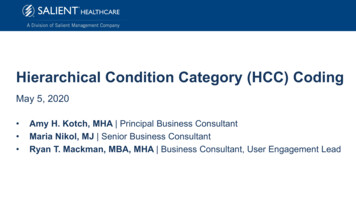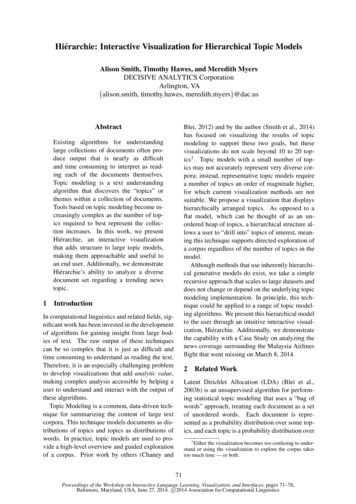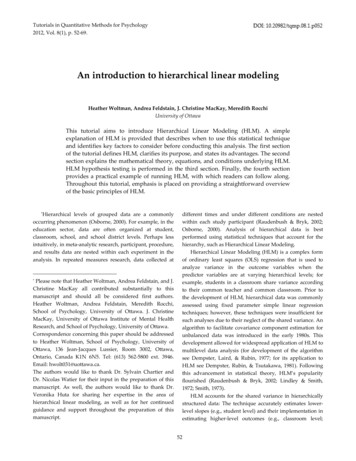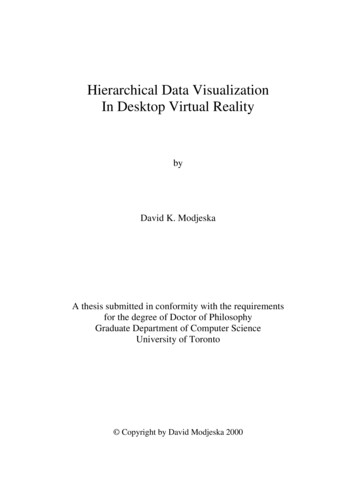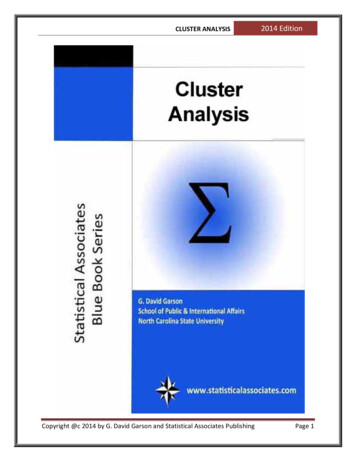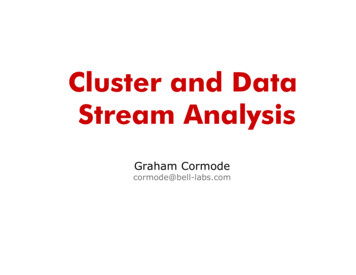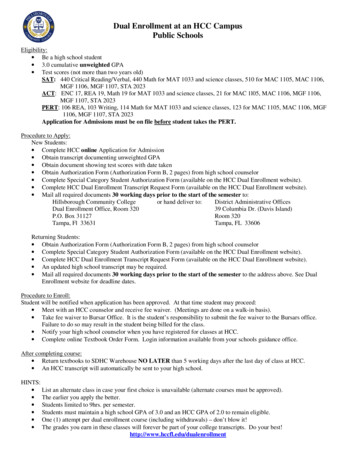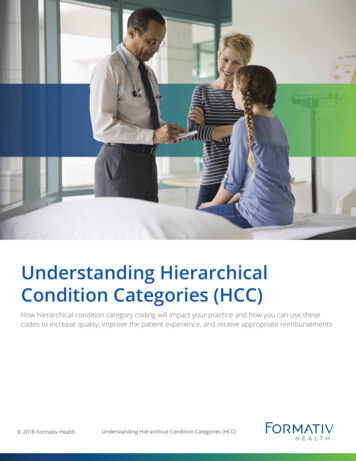
Transcription
Understanding HierarchicalCondition Categories (HCC)How hierarchical condition category coding will impact your practice and how you can use thesecodes to increase quality, improve the patient experience, and receive appropriate reimbursements 2018 Formativ HealthUnderstanding Hierarchical Condition Categories (HCC)
Copyright and DisclaimerThe ‘Understanding HCC’ white paper is published by Formativ Health. No part of this publicationcan be reproduced, copied, or transmitted in any form or by any means, or be stored in aretrieval system of any type, without obtaining prior written permission of Formativ Health.Application for permission to reproduce all or part of this white paper shall be made to FormativHealth.Although the greatest care has been taken in the preparation and compilation of this whitepaper, no liability or responsibility of any kind, to an extent permitted by law, includingresponsibility for negligence is accepted by Formativ Health, its employees, or affiliates. Allinformation gathered and published herein is believed correct as of April, 2018. All correctionsshould be sent to Formativ Health for future editions. 2018 Formativ HealthUnderstanding Hierarchical Condition Categories (HCC)2
Table of ContentsCopyright and Disclaimer .2Table of Contents .3Executive Summary .4Introduction .5HCC coding categories and scoring .7HCC best practices .11Conclusion .12About Formativ Health .13Contact Information .14 2018 Formativ HealthUnderstanding Hierarchical Condition Categories (HCC)3
Executive SummaryFor many years, insurers, physician groups, government agencies, and others in the health careindustry have attempted to replace the pay-for-service model of reimbursement with a modelbased on quality and outcomes. Since the early 2000s, many plans and programs have beenput in place to create a value-based system, one that moves risk from payers to patients andphysicians. Under this new system, health care providers are not paid for the volume of workthey do. Instead, the system pays providers for the quality and value of the services they deliver.As part of this effort, the Centers for Medicare and Medicaid Services (CMS) introduced theHierarchical Condition Category (HCC) in 2003. HCC is a set of codes that CMS uses to determinereimbursements to Medicare Advantage plans. The HCC codes are designed to accurately reflectpatient “acuity” – or the severity of illnesses facing a plan’s members. A Medicare member’shealth status in a given year is used to predict costs in the following year. The correct use of HCCcodes can result in increased payments. Using them incorrectly can result in penalties.Because the health care industry has turned sharply toward value-based, risk-adjustmentmodels for payment, practices must understand HCC and use this coding system to their bestadvantage. To help, this white paper provides an overview of HCC coding and discusses howMIPS scores impact physicians and groups. In addition, the paper offers tips and best practicesto enable your organization to comply with the law and get the most out of the system. 2018 Formativ HealthUnderstanding Hierarchical Condition Categories (HCC)4
IntroductionMedicare, along with many commercial payers, administrators, and physicians, have long soughtto produce a health care system that offers better care at a lower cost, while also improving theexperience for patients. Such a system, most agree, requires the shifting of risk from payers topatients and physicians and implementing a payment model based on quality of services ratherthan volume of services.Health care professionals know that there are serious challenges involved in creating suchas system, and most believe that the key to addressing these challenges is risk adjustment.Medicare has introduced risk adjustment programs that reward payers who take on high riskpatients, including those with chronic conditions. These efforts have been shown to bring bettercare to those with complex care needs and produce cost decreases across the system.To make this process work, Medicare has introduced initiatives like HCC coding. HCC codinghelps Medicare to better understand the actual conditions and projected needs of patients anddetermine reimbursements. Overall, risk adjustment models like HCC bring more clarity to thehealth care system and helps bring reimbursements in line with quality and value rather thanvolume.What is HCC?Created by CMS in 1997 and implemented in 2003, HCC or “Hierarchical Condition Category” is arisk adjustment model that calculates risk scores for aged and disabled Medicare beneficiaries.These scores represent the expected medical costs of a Medicare member in the coming year.CMS uses these risk scores to calculate its per-member/per-month fees to payers.HCC coding seeks to identify Medicare members who have severe or chronic health issues.Individual diagnoses are classified using the International Classification of Diseases-10 or “ICD10.” Some 9,000 ICD-10 codes are matched with the 79 HCC codes contained in the CMS RiskAdjustment model. Based on this information, along with other factors such as age and gender,Medicare members are given a risk factor score, and this score is used to help determineMedicare reimbursements.Recent legislationA large boost to Medicare’s risk adjustment initiative came in 2011 with the passage of theAffordable Care Act (ACA). This groundbreaking bill contained many provisions and incentivesto boost quality and curb costs, and models tying quality to patient expenditures have beenimplemented. 2018 Formativ HealthUnderstanding Hierarchical Condition Categories (HCC)5
More provisions to tie quality to cost came with 2015’s Medicare Access and CHIPReauthorization Act (MACRA). Under MACRA, Medicare began to deny claims that lackeddiagnosis specificity. MACRA also created the Merit-Based Incentive Payment System (MIPS),which determines Medicare payment adjustments to practices based on scores in several keycategories, including how well they report patient acuity using HCC codes. MIPS scores can resultin a practice receiving a bonus payment or paying a penalty.Risk factors and MIPS scoringIn 2017, CMA began scoring physicians and practices on their performance in four key areas,including: Quality – Representing 60% of the score, this performance area concerns quality ofcare, the patient experience, safety, efficiency, and care coordination. HCC codingis part of this measure. Cost – CMS will look at claims data, but performance in this category does notaffect 2019 payments. Improvement activities – This area involves effort to improve clinical practices,such as expanding hours and access, population management, and integratingbehavioral health. It accounts for 15% of the score. Advancing care information – Practices care measured on promoting patientengagement and their use of certified electronic health records (EHR) technology.This measure accounts for 25% of the score.Annual performance in these categories is used to determine a composite MIPS score, which canrange from 0 to 100. MIPS scores are presented relative to other physicians and groups, settinga performance threshold. Those that score above the threshold receive a payment bonus, andthose below pay a penalty. Bonuses are paid for out of the penalty payments. Also, these scoreswill impact a provider’s Medicare reimbursement in each payment year from -9% to 27% by2022.As stated above, CMS uses HCC coding and other information from physicians to determinerisk adjustment factor scores. A patient’s diagnosis or diagnoses is central to the scoring, butCMS looks at other factors as well. For example, a patient’s age will influence the score becauseolder individuals have higher expected health care costs. CMS also considers eligibility status.The organization looks whether a person aged into the Medicare program or became a memberbecause of a disability. In addition, CMS will look at whether a person is enrolled in bothMedicare (because of age) and Medicaid (because a disability). 2018 Formativ HealthUnderstanding Hierarchical Condition Categories (HCC)6
Here’s a breakdown of the CMS risk-adjustment process:Demographics Diagnosis/Diagnoses Risk Adjustment Factor (RAF) ScoreDemographics include: Age Gender Whether the individual lives in the community or in a skilled nursing facility Whether the individual is enrolled in Medicare, Medicaid, or dually eligible for bothprogramsDiagnosis/Diagnoses Diagnosis/diagnoses are recorded using HCC codes. The codes are based on specific ICD-10 codes Medical conditions are hierarchically weighted within the HCC categoriesDetermining Risk Adjustment Factors RAF values are assigned to HCCs RAF score for HCC is higher if the patient is sicker RAF values are additive RAF score of baseline demographics is 1(Source: American Academy of Family Physicians)HCC coding categories and scoringAs mentioned above, MIPS scores are based on demographic factors like age and gender, aswell as diagnoses for chronic or life-changing illness. The CMS Risk Adjustment Model includes79 HCC categories of diagnoses for chronic illnesses, matched to thousands of ICD-10 diagnosiscodes. Among the most commonly reported diagnoses are: Chronic obstructive pulmonary disease Diabetes Congestive heart failure Ischemic or unspecified stroke Vascular disease Angina Cancer Rheumatoid arthritis Ischemic heart disease Inflammatory connective tissue disease Specified heart arrhythmia 2018 Formativ HealthUnderstanding Hierarchical Condition Categories (HCC)7
It is important to remember that one of the key goals of HCC coding is to predict use of medicalservices for Medicare members in the year to come. For this reason, HCC diagnosis codinglooks at all conditions a patient has been diagnosed with over the past year, which places greatimportance on recording comorbidities.The coding assigns a weight to each condition. These weights, combined with demographicfactors, determine the HCC score. High scores mean that a patient has more complex andserious conditions and will use more health services, resulting in higher costs in the future.Below is an example of how complete and accurate HCC coding RAF scores and reimbursementamounts.HCC reporting for an 82-year-old female:Scenario 1: RAF base score 0.7 – Based on demographics for an 82-year-old female - age, sex,community vs. SNF, Medicare/Medicaid eligibilityDiagnoses per chart documentationHCCRAFBaseN/ARAF 0.7Total RAF 0.7Based on an average per patient-per month payout of 1,000, baseline annual payout withcomorbidity conditions:0.7 x 1,000 x 12 mos. 8,400 per year 2018 Formativ HealthUnderstanding Hierarchical Condition Categories (HCC)8
Scenario 2: RAF base score 0.7 with more specific documentation of conditions and treatmentsDiagnoses per chart documentationHCCRAFBaseN/ARAF 0.7DMHCC 19 Tyoe II DMw/o ComplicationsRAF 0.121ObesityNoneBME 36 (STARS)NoneHTNNoneInsomniaNoneMajor Depression, single episodeNone (severity notdocumented)SmokerNonePMH Breast CNoneTotal RAF 0.821Based on an average per patient-per month payout of 1,000, baseline annual payout withcomorbidity conditions:0.821 x 1,000 x 12 mos. 9,852 2018 Formativ HealthUnderstanding Hierarchical Condition Categories (HCC)9
Scenario 3: RAF base score 0.7 with even more specific documentation of conditions andtreatmentsDiagnoses per chart documentationHCCRAFBaseN/ARAF 0.7Type II DM with diabetic CKDHCC 18 - Diabetesw/ complicationRAF 0.374 CDK Stage 4HC 137RAF 0.153Diabetic peripheral angiopathyHC 108 (HC18 DMw/comp alreadyassigned)RAF 0.319Diabetic non-pressure foot ulcer, RheelHCC 161RAF 0.628Amputation lower extremity L 2nd toeHCC 189RAF 0.721Morbid Obesity(BMI 36 DM, HTN due to obesity)HCC 22RAF 0.295Hypertensive HF, chronic systolic HFHCC 85RAF 0.365Major Depression, single episode, mildHCC 58RAF 0.300Sedative-hypnotic Dependence, uncomplicatedHCC 55RAF 0.336COPDHCC 111RAF 2.6Metastatic CA to spineHCC 8Total RAF 7.16Based on an average per patient-per month payout of 1,000, baseline annual payout withcomorbidity conditions:7.16 x 1,000 x 12 mos. 85,920(Source: American Academy of Family Physicians) 2018 Formativ HealthUnderstanding Hierarchical Condition Categories (HCC)10
HCC best practicesTo comply with CMS regulations, provide the best and most efficient service to your patients,and receive the reimbursements you deserve, physicians and practices must master HCC coding.Here are some steps you can take:Focus on accuracy – CMS can and will deny claims for a lack of “diagnosis specificity,” so it is inyour best interest to provide the most complete and accurate information. Take a long, hardlook at your practice. Make sure you have systems in place to capture the necessary informationabout your patients’ conditions and the services you provide. Reflect that information in yourreporting and billing.Understand your patient population – If you serve Medicare patients, it’s more than likelythat many of them have been diagnosed with diabetes, vascular disease, or one or more of theother most common HCC diagnoses. Take a look at your patients and determine who belongs inwhat diagnosis category. Also, work with your administrative and clinical staff to place the rightpatients with the right diagnosis, and keep up-to-date, accurate records.Capture comorbidities – To make sure you are providing all necessary services to a patient andto avoid claims denial for a lack of “diagnosis specificity,” be sure to capture every diagnosis. Forexample, if one of your patients has diabetes, but also hypertension and depression, make sureall conditions are captured. Remember: CMS requires that clinicians provide proof of the risksassociated with each patient, and the HCC payment structure is based on accurate reporting. Arecord can have more than one HCC code.Report every year – The CMS risk management model is built on reviewing a previous year’shealth status to predict the following year’s health expenses. That means physicians andpractices must report their information to CMS every year. Get in the habit of using HCC codesand submitting accurate information in a timely fashion. 2018 Formativ HealthUnderstanding Hierarchical Condition Categories (HCC)11
ConclusionAlthough HCC has been around for nearly 20 years, many health care professionals are not fullyaware of the importance and implications of the risk adjustment model. This needs to change.The move from fee-for-service to pay-for-performance began a long time ago, and the healthcare industry is not going back. CMS reimbursements and potential bonuses and penalties aretied to HCC, meaning that clinicians and practices must take steps to ensure compliance andaccuracy.All health care professionals must take steps to understand HCC and incorporate best practicesin claims and coding. Ultimately, HCC and other risk adjustment efforts will help the entireindustry bring higher quality care to more people at a lower cost. 2018 Formativ HealthUnderstanding Hierarchical Condition Categories (HCC)12
About Formativ HealthWe are redefining the ambulatory patient and provider experience throughout the health careecosystemOur purposeTo transform the patient and provider experience and make health care better for both.Our approachWe partner with physician practices, hospitals, and health systems to improve financial health,enhance the patient experience, and free up physicians to focus on what they do best – takingcare of patients. 2018 Formativ HealthUnderstanding Hierarchical Condition Categories (HCC)13
Contact Information130 East 59th Street, 15th Floor,New York, NY ativhealth.com 2018 Formativ HealthUnderstanding Hierarchical Condition Categories (HCC)14
Understanding Hierarchical Condition Categories (HCC) How hierarchical condition category coding will impact your practice and how you can use these codes to increase quality, improve the patient experience, and receive appropriate reimbursements. 2018 Formati ealt nerstanin ierarcical onition ateories 2

